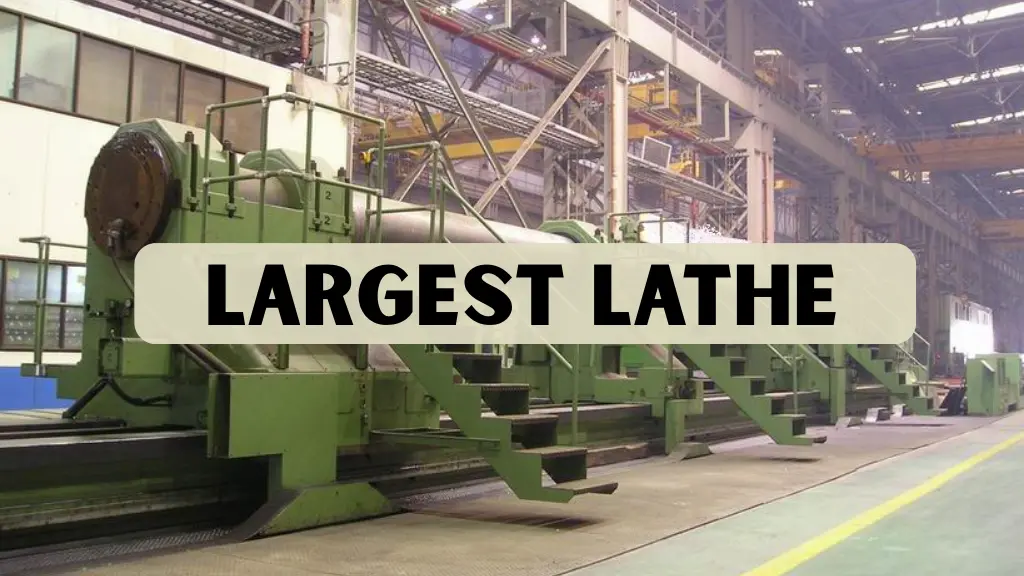In industrial engineering, lathes are some of the most critical machines for shaping and finishing materials. They range from compact workshop models to massive systems capable of machining components weighing hundreds of tons. Among them, the largest lathe in the world represents a landmark achievement in precision, scale, and engineering innovation. It is both a functional tool and a symbol of human advancement in manufacturing technology.
This article explores the history, design, and applications of these monumental machines. Readers will gain insights into their technical specifications, the industries that rely on them, and the challenges involved in operating such equipment. By examining real-world examples and modern advancements, it becomes clear why these lathes remain vital for projects that require unmatched accuracy and the capacity to handle components at an extraordinary scale.
What Is a Lathe?
A lathe is a versatile machine tool that rotates a workpiece on its axis to perform cutting, drilling, sanding, or shaping operations. Its primary function is to create components that are symmetrical around a central axis. Over the years, various types of lathes have been developed to meet industrial demands, ranging from small workshop machines to advanced CNC systems. Each type serves a unique role in modern manufacturing.
Engine lathes are commonly found in workshops for everyday tasks, while turret lathes are designed for repetitive production in industrial settings. CNC lathes bring precision and automation, enabling complex machining with minimal error. At the extreme end of the spectrum, specialized large lathes are custom-built to handle massive workpieces like turbine rotors, ship propellers, or industrial rolls. The large lathe falls into this category, designed for projects beyond the capacity of conventional machines.
Historical Development of Large Lathes
Lathes have evolved for thousands of years, beginning as simple manual machines in ancient civilizations. The earliest known lathes date back to Egypt around 1300 BCE, where artisans operated them using bowstrings to rotate wooden objects.
The Industrial Revolution brought powered lathes, first driven by steam engines and later by electric motors. These innovations allowed lathes to handle heavier workpieces with improved precision. By the 20th century, engineers began designing ultra-large lathes capable of machining components that weigh hundreds of tons.
Industries such as shipbuilding, energy production, and aerospace required these massive machines to produce single-piece components. Machining these parts on smaller machines was impossible due to limitations in size and structural rigidity.
The Largest Lathe in the World
The Waldrich Siegen lathe, constructed in South Africa in 1973, is widely recognized as the largest lathe in the world. Measuring over 126 feet in length and weighing about 485 tons, it was designed to handle massive workpieces that smaller machines could never manage. Its ability to machine components weighing up to 330 tons positioned it as a critical asset for heavy industries such as energy, aerospace, and shipbuilding.
What makes this machine particularly remarkable is its engineering precision at such a massive scale. With high-rigidity frames, CNC-controlled feeds, and advanced lubrication systems, the lathe ensures micrometer-level accuracy even under extreme load. For industries that rely on flawless machining of turbine rotors, steel shafts, or oversized ship parts, this level of reliability is not just impressive, it’s essential. A small error on such projects could result in millions of dollars in losses, underscoring the expertise behind its design.
The Waldrich Siegen lathe also demonstrates the authority of industrial engineering in solving real-world challenges. From designing torque-rich motors to implementing advanced cooling systems, engineers applied decades of knowledge to ensure uninterrupted operation. Its continued recognition today reflects the trustworthiness of its design, proving that even decades later, this machine remains an engineering marvel.
Industrial Applications of Giant Lathes
The largest lathe is more than an engineering giant; it is indispensable to industries where scale and precision drive progress. In shipbuilding, it machines propellers, shafts, and structural parts with accuracy that ensures safety and reliability. The energy sector depends on it to produce turbine rotors for hydro, nuclear, and thermal power plants, where even the smallest error could compromise performance. Aerospace also benefits, with this machine crafting critical components for rockets and fuselages.
Beyond these high-tech industries, steel and paper mills rely on massive lathes to produce industrial rolls that support global production. By enabling the machining of enormous workpieces as a single unit, manufacturers reduce assembly errors, save time, and improve operational efficiency. This combination of scale, innovation, and reliability highlights its role as a cornerstone of modern industrial manufacturing.
How the Giant Lathe Works
The working principle of a heavy-duty industrial lathe mirrors that of smaller machines, though the scale introduces unique challenges. The core process involves rotating the workpiece while specialized cutting tools remove material to achieve the desired shape. Advanced CNC systems manage precision, ensuring micron-level accuracy across vast surfaces. This demonstrates both engineering expertise and reliability in large-scale machining.
To achieve this, carbide or diamond-tipped tools are employed to withstand extreme cutting forces. Hydraulic chucks, tailstocks, and support systems stabilize massive workpieces throughout the process. By integrating these elements, engineers create components with exact dimensions and smooth finishes. Such capabilities highlight the authority of large lathes in industries requiring strength and precision.
Advantages of Ultra-Large Lathes
Investing in the largest lathe offers unmatched precision on a massive scale, achieving micron-level accuracy even with extremely heavy components. This eliminates common errors found in traditional methods where multiple smaller parts must be joined. By machining a single piece, industries save time, reduce assembly challenges, and improve overall product integrity. Such precision underscores the engineering expertise required to operate these advanced machines.
Beyond accuracy, these machines deliver industrial efficiency by lowering labor requirements and cutting down on project timelines. Their ability to work continuously under high stress makes them indispensable in sectors like aerospace, shipbuilding, and power generation. Using advanced materials such as titanium and composites, they adapt to the demands of modern production. This versatility highlights their long-term value in global manufacturing.
Long-term reliability is another defining benefit of extra-large machining centers. Built with robust structures and advanced lubrication systems, they are designed for continuous use without compromising safety. These qualities demonstrate why industries worldwide view giant machining equipment as critical infrastructure. They ensure durability, efficiency, and consistency for projects where scale and precision cannot be compromised.
Notable Examples
While the Waldrich Siegen holds the crown in historical significance, other lathes stand out for their own groundbreaking achievements. The Wuhan Heavy Duty Machine Tool Group’s DL250 lathe in China, for example, pushes the boundaries of weight capacity, capable of machining parts up to 500 tons. This makes it one of the heaviest-duty lathes in operation, serving industries that require oversized rotors and generators.
Japan also contributes with the Shin Nippon Koki rotor lathes, which can handle up to 400 tons. These machines are designed with a focus on the energy sector, where precision in manufacturing turbine rotors and other large-scale components is critical. By combining decades of Japanese expertise in mechanical engineering with advanced control systems, Shin Nippon Koki has created machines that set a benchmark in reliability and accuracy.
In Europe, Gurutzpe of Spain brings innovation with its multitasking lathe models, which can machine components up to 18 meters long and weighing 120 tons. Unlike traditional heavy-duty lathes, these machines integrate multitasking capabilities such as milling and drilling, offering greater efficiency for complex industrial projects. These examples highlight how different regions of the world contribute unique expertise and innovation to the field of large-scale lathes.
Case Study
A lathe was employed to machine a 120-ton turbine rotor for a hydroelectric power plant in India. The process required aligning the rotor to within 0.01 millimeters, showcasing the expertise and precision necessary for such massive projects. Operators maintained continuous operation for 48 hours, executing multiple tool changes with accuracy. This level of performance illustrates deep industry knowledge and engineering authority.
By integrating CNC-controlled hydraulic feeds, the team ensured both precision and efficiency in the machining process. The final outcome was a fully machined rotor that fit seamlessly into the generator assembly. This achievement highlights how the heavy duty lathe supports projects where size and accuracy are non-negotiable. It also reinforces trust in advanced technology’s ability to meet critical industrial demands.
Maintenance and Safety Considerations
Operating and maintaining a heavy-duty lathe requires highly skilled professionals who combine technical knowledge with practical experience. Regular calibration helps sustain precision, while lubrication systems reduce friction and extend component life. These steps demonstrate expertise in handling machines that work under extreme loads. Consistent care ensures reliability and builds trust in industrial performance.
Safety remains a top priority, with protocols such as guarding, vibration monitoring, and emergency stops protecting operators at all times. Skilled technicians must also master both mechanical and CNC systems for effective operation. Proper training enhances authority in managing advanced machinery while reducing risks. With careful maintenance, these lathes achieve efficiency, safety, and long-term durability.
Future Trends in Large Lathe Technology
Automation and AI are transforming modern manufacturing by allowing giant lathe machines to self-monitor tool wear and adjust cutting paths with precision. This reduces downtime, improves accuracy, and demonstrates the expertise of engineers applying advanced technology to industrial operations. Stronger alloys are also being introduced, ensuring that even the heaviest components can be shaped without risk of deformation. These developments show how real-world experience and innovation are reshaping large-scale machining.
Digital twin technology further enhances trust and efficiency by allowing engineers to simulate machining processes before actual production begins. Combined with energy-efficient motors and advanced cooling systems, these machines meet both industrial and environmental standards. Industries such as aerospace, shipbuilding, and power generation rely on this proven technology to achieve precision and sustainability.
Conclusion
The largest lathe stands as a true marvel of industrial engineering, designed to handle massive components with unmatched precision. Its ability to shape turbine rotors, ship shafts, and aerospace parts highlights the experience and expertise of the engineers who operate it. This machine combines scale, accuracy, and advanced technology to deliver results that smaller systems cannot achieve.
Across industries such as shipbuilding, energy, steel production, and aerospace, its role remains critical for efficiency and reliability. By integrating CNC systems, stronger materials, and sustainable practices, it continues to evolve with modern demands. As a trusted symbol of progress, it demonstrates how engineering innovation pushes the limits of what is possible in manufacturing.
FAQs
What is the biggest lathe ever built?
The Sarokhani lathe is currently recognized as the largest, capable of handling workpieces more than 100 feet long and weighing up to 165 tons.
Why are large lathes important in modern industry?
Large lathes allow the production of single-piece components for turbines, ship propellers, and aerospace parts. They reduce assembly errors and improve overall efficiency.
How do engineers maintain precision on such large machines?
CNC control, high-rigidity frames, advanced tooling, and regular calibration maintain precision.
Are the heavy duty lathes automated?
Yes, modern large lathes use CNC systems and sometimes integrate AI-based monitoring for efficiency and accuracy.
Where can I see a large lathe in operation?
These machines are typically found in industrial manufacturing plants, hydroelectric power facilities, and large-scale shipyards. Due to safety considerations, visits usually require special permission.




